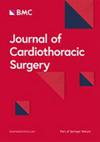评估无创肝纤维化指数和门静脉直径在预测肝硬化患者食管静脉曲张出血方面的预测效果
IF 1.5
4区 医学
Q3 CARDIAC & CARDIOVASCULAR SYSTEMS
引用次数: 0
摘要
本研究旨在评估无创血清肝纤维化标志物和门静脉直径(PVD)在预测肝硬化患者食管静脉曲张出血(EVB)发生方面的诊断准确性。由 102 名肝硬化患者组成的队列被分为两组:P 组(无 EVB)和 PE 组(有 EVB)。我们进行了一项综合分析,比较了两组患者的各种无创血清肝纤维化指数、Child-Pugh 分级、天冬氨酸氨基转移酶与丙氨酸氨基转移酶的比率、天冬氨酸氨基转移酶与血小板比率指数、基于四个因子的纤维化指数(FIB-4)、PVD 和脾脏厚度(SPT)。对两组间存在显著差异的变量绘制了接收者操作特征曲线(ROC),随后计算了每个变量的 ROC 曲线下面积(AUROC)。单变量分析结果显示,P 组和 PE 组的血清肝纤维化标志物存在显著差异,包括透明质酸(HA)、III 型胶原蛋白(PC-III)、IV 型胶原蛋白(IV-C)、PVD、SPT 和 FIB-4(P < 0.05)。这些标记物的 AUROC 值分别为 0.653、0.706、0.710、0.730、0.660 和 0.633。此外,在与 PVD、SPT 和 FIB4 整合后,肝纤维化标记物的 AUROC 值相应飙升至 0.793、0.763 和 0.706,凸显了诊断潜力的增强。无创性肝纤维化指标与 PVD 的整合显示了 EVB 的显著诊断潜力,凸显了其在预测出血事件方面的临床意义。本文章由计算机程序翻译,如有差异,请以英文原文为准。
Assessing the predictive efficacy of noninvasive liver fibrosis indices and portal vein diameter in predicting esophageal variceal bleeding in patients with cirrhosis
The objective of this study is to evaluate the diagnostic accuracy of noninvasive serum liver fibrosis markers and portal vein diameter (PVD) in predicting the occurrence of esophageal variceal bleeding (EVB) in patients with cirrhosis. A cohort comprising 102 individuals diagnosed with cirrhosis was divided into two groups: the P group (without EVB) and the PE group (with EVB). We conducted a comprehensive analysis comparing various noninvasive serum liver fibrosis indices, the Child-Pugh classification, ratios of aspartate aminotransferase to alanine aminotransferase, aspartate aminotransferase to platelet ratio index, fibrosis index based on four factors (FIB-4), PVD, and spleen thickness (SPT) between these groups. Receiver operating characteristic (ROC) curves were constructed for variables showing significant differences between the two groups, with subsequent calculation of the area under the ROC curve (AUROC) for each variable. Significant distinctions were noted in the serum liver fibrosis markers between the P and PE groups, encompassing hyaluronic acid (HA), type III procollagen (PC-III), type IV collagen (IV-C), PVD, SPT, and FIB-4 (p < 0.05), as evidenced by univariate analysis findings. The respective AUROC values for these markers were 0.653, 0.706, 0.710, 0.730, 0.660, and 0.633. Additionally, upon integration with PVD, SPT, and FIB4, the AUROC values for liver fibrosis markers surged to 0.793, 0.763, and 0.706 correspondingly, highlighting the enhanced diagnostic potential. The integration of noninvasive liver fibrosis indices and PVD showcased remarkable diagnostic potential in EVB, underscoring its clinical relevance in predicting hemorrhagic events.
求助全文
通过发布文献求助,成功后即可免费获取论文全文。
去求助
来源期刊

Journal of Cardiothoracic Surgery
医学-心血管系统
CiteScore
2.50
自引率
6.20%
发文量
286
审稿时长
4-8 weeks
期刊介绍:
Journal of Cardiothoracic Surgery is an open access journal that encompasses all aspects of research in the field of Cardiology, and Cardiothoracic and Vascular Surgery. The journal publishes original scientific research documenting clinical and experimental advances in cardiac, vascular and thoracic surgery, and related fields.
Topics of interest include surgical techniques, survival rates, surgical complications and their outcomes; along with basic sciences, pediatric conditions, transplantations and clinical trials.
Journal of Cardiothoracic Surgery is of interest to cardiothoracic and vascular surgeons, cardiothoracic anaesthesiologists, cardiologists, chest physicians, and allied health professionals.
 求助内容:
求助内容: 应助结果提醒方式:
应助结果提醒方式:


